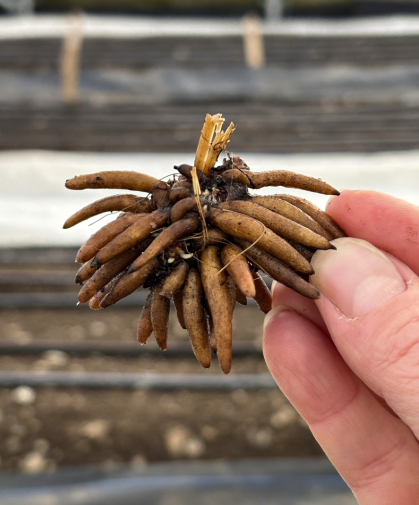Ranunculus - Key Growing Information

Soaking: This process is essential for deeply hydrating the dry, dormant root material and initiating a growth cycle. Soak corms for 8–12 hours in water at a temperature of 77°F (25°C). Ensure that all the corms stay submerged under water for the entire soaking period.
Chilling Treatment: Chill by holding corms at 40–50°F (5–10°C) for 3 weeks after soaking. These cool temperatures can be achieved either by holding corms in cold storage or by planting directly into garden beds while soil temperatures are within the desired range. Corms chilled in cold storage can either be stored loose in peat or vermiculite or in soil in seedling trays. For more information on chilling methods, consult our Ranunculus Production Guide.
Planting and Sprouting: After soaking and chilling, corms can be planted directly into soil or as transplants. Whether in soil or in trays, this stage of sprouting and shoot development should take about 2–4 weeks in temperatures 55–60°F (12–16°C). Planting Loose Corms: To plant corms directly into the soil, place corms with the center of the corm facing up and fingers/roots facing down into the soil. Take care not to damage the roots during the planting process. Cover the corms with 1/8– 1/4" soil. Planting Corms as Transplants: after having been chilled in their seedling trays (consult our Ranunculus Production Guide for details), grow corms at 55–60°F (12–16°C) until roots and shoots develop and plants are ready to transplant. Water trays well. Soil should remain moist but not saturated.
Light Preference: Sun.
Plant Height/Stem Length: Butterfly ranunculus: 18–36". Romance ranunculus: 14–24".
Plant Spacing: Butterfly ranunculus: 10–12" apart within the row, with 12–14" between the rows. Romance ranunculus: 6–8" apart within rows and 8–10" apart between rows.
Hardiness Zones: Typically grown as an annual in a tunnel or greenhouse. In USDA hardiness zones 7 and greater, ranunculus can perennialize and be grown outdoors. While established plants can tolerate light frosts, exposure to freezing temperatures is not recommended and unsprouted corms should never be allowed to freeze.
Vase Life: 10 days. Place cut stems into cold water and store at 34–40°F (1–4°C).
Harvest: Harvest flowers only early in the morning, if possible. Use a knife or snippers to cut the stem at ground level. Do not pull the stems from the bulb; this can result in pulling up or damaging the plant. Harvest window is 2–4 weeks, depending on conditions. Temperatures consistently above 70°F (21°C) may trigger dormancy in the plants resulting in a shorter harvest window and a decline in bloom quality. Butterfly ranunculus: Harvest once 2–3 flowers on the stem are showing color and 1 flower is open. Romance ranunculus: Cut blooms at the "marshmallow stage," once the blooms color-up and feel springy like a marshmallow and before they fully open. For maximum bloom size and showy flowers, allow the flowers to open and close for 3 days before harvest.
Soil Requirements: Cool, moist, well-drained soil. Ideal soil pH: 5.8–6.3; ideal EC (electrical conductivity): 1.3 to 1.5.
Pests and Disease: Both corms and plants are attractive to rodents. Protect the crop from rodent damage throughout the crop's lifecycle. Use of fungicide treatment during the sprouting process can greatly reduce chances of crop loss from root rot pathogens.
Uses: Cut flower.
Scientific Name: Ranunculus asiaticus
Alternate Common Names: Persian buttercup, Persian crowfoot, Asian buttercup

